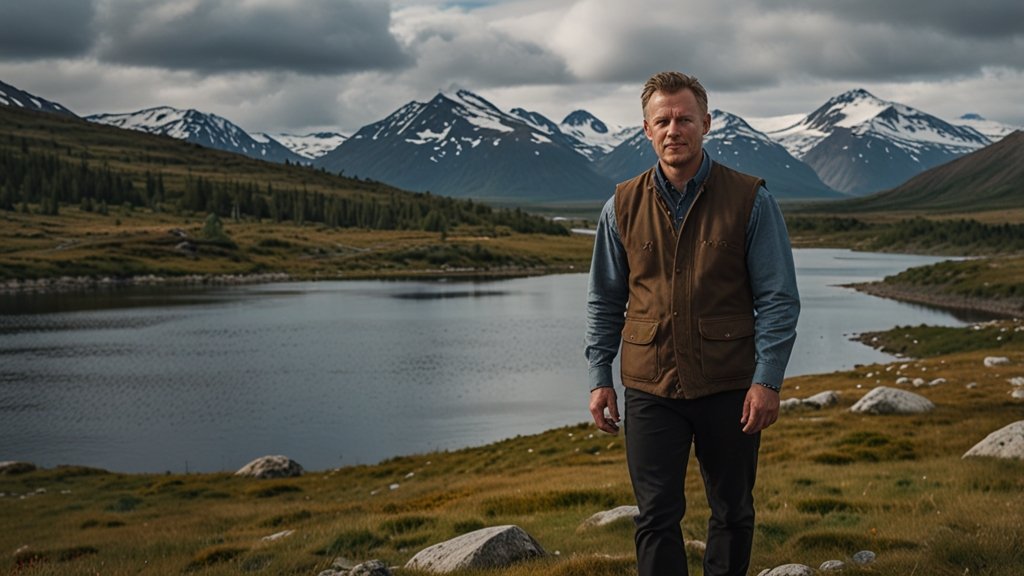You know that feeling? That deep, almost primal tug towards the wild places? Where the air tastes sharper, the silence hums louder, and every shadow seems to hold a story older than memory? Forget the well-trodden paths for a moment. Tucked away in the formidable embrace of the Northern Mountains lies Örviri. It’s not just a dot on a map; it’s an experience carved by glaciers, painted by legends, and breathed alive by a spirit you won’t find anywhere else. Honestly, most “top destinations” lists haven’t caught on yet, and maybe that’s part of its raw magic.
Think majestic, snow-dusted peaks piercing a perpetually crisp sky. Think valleys carpeted in emerald during fleeting summers, exploding into fiery hues of crimson and gold come autumn. Think crystalline rivers cascading down ancient rock faces, carving secrets into the landscape. But Örviri offers more than just a pretty postcard. It’s a place where the veil between the present and the deep past feels tantalizingly thin. Local folklore isn’t just stories here; it’s the very breath of the land, woven into the wind, etched onto the stones, and murmured by the pines. For the adventurer seeking raw beauty and the explorer hungry for cultural resonance, Örviri isn’t just a destination; it’s a pilgrimage. Buckle up – we’re diving deep into why this Northern Mountain jewel deserves your next daring stamp in the passport.
Here’s what we’ll uncover:
- Örviri Unveiled: Gateway to the Northern Wilds (Setting the scene, geography, initial impact)
- Nature’s Grand Theatre: Örviri’s Breathtaking Landscapes (Key natural features, seasonal transformations)
- Whispers on the Wind: The Soul-Stirring Folklore of Örviri (Core legends, cultural significance, the “living myth” feel)
- Echoes in Stone: Unraveling Örviri’s Cultural Tapestry (Historical roots, local traditions, archaeological whispers)
- Answering the Call: Adventures for the Örviri Explorer (Hiking, trekking, wildlife, photography – the practical draw)
- Beyond the Guidebook: The Intangible Magic of Örviri (That feeling you get there – personal insight territory)
- Örviri vs. Other Northern Gems: Finding Your Fit (A quick comparison – because context matters!)
- Planning Your Örviri Odyssey: The Nitty-Gritty (Seasons, access, essentials, respecting the land)
- Your Örviri Questions, Answered (FAQ) (Burning queries tackled head-on)
1. Örviri Unveiled: Gateway to the Northern Wilds
cture this: You’ve navigated winding roads that cling stubbornly to mountainsides, forests growing denser, air growing cooler. Then, the valley opens. Before you, cradled like a precious stone in the fist of giants, lies Örviri. It hits you first with sheer scale. Those Northern Mountains aren’t messing around; they loom with a quiet, ancient authority. Jagged peaks, some still crowned with snow even in high summer, frame the village and its surrounding wilderness. The dominant feature? Often it’s Mount Hvildar (or whatever the local name is – let’s say “Whisper Peak” for flavour), its summit frequently shrouded in mist, lending an air of perpetual mystery.
The village itself? Don’t expect sprawling resorts. Örviri is typically a cluster of sturdy, weathered wooden buildings, perhaps stone foundations showing their age, smoke curling lazily from chimneys. Functional, resilient, built by generations who understood the mountain’s moods. The vibe isn’t bustling; it’s present. It’s the quiet hum of a place deeply connected to its environment. Your first breath here feels different – cleaner, colder, somehow more alive. It’s the kind of place where you immediately slow down, almost involuntarily. The frantic pace of “down below” feels like a distant dream. You’ve arrived at the edge, and the edge has a powerful allure.
2. Nature’s Grand Theatre: Örviri’s Breathtaking Landscapes
Alright, let’s talk eye candy, because Örviri delivers in spades. This isn’t manicured parkland; it’s nature unleashed, sculpted by ice and time.
- The Peaks: Obviously, the mountains dominate. But look closer. You’ll see dramatic cirques (those amphitheatre-like valleys carved by glaciers), razor-sharp arêtes (ridges), and U-shaped valleys stretching out like frozen rivers of earth. Mount Hvildar might be the star, but the supporting cast of surrounding summits is equally impressive, offering endless vistas for the intrepid hiker.
- The Valleys & Forests: Below the treeline, a different magic unfolds. Dense coniferous forests – spruce, pine, fir – cloak the slopes in deep, perpetual green. Venture in, and sunlight filters through in dappled shafts. Moss carpets the ground, muffling sound. In autumn? Forget it. It’s an explosion of colour that would make a painter weep – birches and aspens turning the valleys into molten gold and fire. Örviri’s valleys are sanctuaries for wildlife and solitude seekers.
- The Water: Water is lifeblood here. Glacial melt feeds countless streams, tumbling over rocks with a constant, soothing chatter. Look for waterfalls – sometimes hidden gems tucked away off the main trails, sometimes dramatic cascades visible for miles. Mirror Lake (or its local equivalent – “Stillvatn” perhaps?), often found near the village, lives up to its name on calm days, perfectly reflecting the surrounding peaks and sky. It’s a place for quiet contemplation, or maybe spotting elusive birds.
- Seasonal Spectacle: Örviri transforms radically. Summer brings bursts of wildflowers in alpine meadows, long days for exploration, and a vibrant green lushness. Autumn is pure drama with its fiery palette. Winter? It becomes a silent, snow-blanketed wonderland, perfect for snowshoeing or cross-country skiing under impossibly starry skies. Spring is the awakening – snowmelt roaring, the first brave flowers pushing through, the air buzzing with renewal. Each season offers a distinct, equally compelling Northern Mountain experience.
3. Whispers on the Wind: The Soul-Stirring Folklore of Örviri
Here’s where Örviri transcends the merely scenic and enters the realm of the deeply resonant. You can’t spend time here without feeling it. The stories aren’t confined to books; they permeate the air. Locals speak of the Huldufólk – the “hidden people.” Not necessarily malevolent, but powerful spirits of the land, dwelling within certain rocks, waterfalls, or ancient trees. Disturb their homes at your peril, or show respect, and you might find favour.
Then there’s the legend of The Guardian of Hvildar. Tales speak of a vast, ancient spirit – perhaps taking the form of an immense bird, a spectral light, or simply a presence – that watches over the peak and the valley below. Some say it guides lost travellers in blizzards; others warn it tests the hearts of those who climb too arrogantly. Is it pure myth? A personification of the mountain’s raw power? Or something else entirely? Frankly, after a night under Örviri’s stars, listening to the wind sigh through the pines, you might find yourself less skeptical.
Stories abound of lost settlements swallowed by glaciers, of singing stones that predict the weather, of paths that appear only to the pure of heart. These aren’t just quaint tales; they’re a fundamental part of how the landscape is understood and navigated. They speak to a deep respect for nature’s power and mystery, a worldview where humans are participants, not dominators. You’ll feel this folklore in the respectful way locals point out landmarks, in the slight hesitation before entering certain groves, in the names given to places – names that often translate to things like “Spirit’s Rest” or “Echoing Stone.” It adds a layer of profound depth to every step you take.
4. Echoes in Stone: Unraveling Örviri’s Cultural Tapestry
The human history of Örviri, while perhaps less fantastical than the folklore, is no less fascinating. Evidence suggests nomadic peoples traversed these valleys millennia ago, following reindeer herds and leaving behind subtle traces – perhaps enigmatic rock carvings depicting animals and celestial bodies found in sheltered overhangs.
Later came more permanent settlers – hardy folk drawn by resources like timber, minerals (though large-scale mining often bypassed this specific, challenging spot), and pastureland. Life was, and still is for some, defined by resilience and adaptation. Traditional crafts thrive here: intricate woodworking (often featuring motifs inspired by local legends), wool spinning and knitting using patterns passed down generations, perhaps distinctive local cuisine focused on foraged berries, mushrooms, mountain fish, and preserved meats. Örviri’s cultural heritage is one of practicality intertwined with deep respect for the environment, shaped profoundly by the isolation and demands of the Northern Mountains.
You might find a small, ancient stone church or shrine on the outskirts, its simple architecture speaking volumes about the community’s faith and endurance. Local festivals, often tied to solstices, harvests, or specific saints’ days, offer glimpses into traditions kept alive through song, dance, and communal feasting. These events feel authentic, not staged for tourists – a genuine celebration of place and continuity. Archaeological surveys occasionally turn up remnants of old settlements or trading routes, hinting at Örviri’s place in a wider, albeit sparse, historical network across this rugged terrain.
5. Answering the Call: Adventures for the Örviri Explorer
So, you’re intrigued by the landscapes and legends? Good. Now, how do you experience Örviri? This isn’t a place for lazy beach lounging (unless that beach is beside Mirror Lake on a rare hot day!). It’s for those who want to earn their views and stories.
- Hiking & Trekking: This is the prime activity. Trails range from gentle walks along valley floors (accessible to most fitness levels, offering stunning views of the peaks and forests) to challenging, multi-day treks ascending high passes and skirting glaciers. Reaching a viewpoint like Hvildar’s Lookout after a steep climb is a reward that stays with you. Always check conditions and hire a local guide for serious backcountry ventures – weather changes fast, and trails can be rough. Remember the folklore; respect the terrain.
- Wildlife Watching: Keep your eyes peeled! Örviri’s wilderness is home to reindeer (often semi-domesticated herds), elusive lynx, foxes, eagles soaring on thermals, and countless bird species. Dawn and dusk are prime times. Patience and quiet are your best tools.
- Photography: Bring extra memory cards. Seriously. From the macro detail of a dew-covered spiderweb in the forest to the vast panoramas from the high ridges, Örviri is a photographer’s dream. Capture the play of light on the peaks, the textures of ancient wood and stone in the village, the ethereal quality of mist rolling through the valley.
- Cultural Immersion: Spend time in the village. Visit the small community centre or craft workshop if open. Chat (respectfully!) with locals at the inn or shop. Attend a festival if your timing aligns. Learn a few basic phrases in the local language – the effort is appreciated. Understanding the people deepens the connection to the place.
- Winter Activities: When snow blankets Örviri, it transforms into a serene, challenging wonderland. Snowshoeing and cross-country skiing open up the silent forests and frozen lakes. Experienced adventurers might tackle ice climbing on frozen waterfalls (with proper gear and guides!). The Northern Lights, when active, dance spectacularly over the snowy peaks – a truly magical sight.
6. Beyond the Guidebook: The Intangible Magic of Örviri
You can list the sights and activities, but describing the feeling of Örviri is trickier. It’s the profound quiet that isn’t silence, but a symphony of wind, water, and distant bird calls. It’s the almost overwhelming sense of scale when you stand dwarfed by the peaks. It’s the crispness of the air that feels like it’s scrubbing your lungs clean.
It’s the moments of unexpected connection: sharing a thermos of coffee with a taciturn local shepherd who points out an eagle’s nest, or sitting by a crackling fire in the village inn as someone recounts a “true” story about the Huldufólk, half in jest, half in earnest belief. It’s the way the light hits a particular ridge at sunset, turning it molten gold, and you just know why it’s called “Sunset Ridge” in the old tongue.
There’s a rawness, an authenticity here that’s increasingly rare. Örviri hasn’t been polished for mass consumption. It demands a bit more from you – preparation, respect, openness. In return, it offers something genuine: a reconnection to wilderness, a brush with ancient stories, and a perspective shift that lingers long after you descend back to the lowlands. It’s restorative in a deep, soul-level way. Some experts talk about “thin places” where the boundary between worlds feels permeable; Örviri absolutely fits that description for many who visit.
7. Örviri vs. Other Northern Gems: Finding Your Fit
The Northern Mountains hold many treasures. How does Örviri stack up? Let’s break it down simply:
| Feature | Örviri | More Developed Resort (e.g., Fjellheim) | Remote Wilderness Area (e.g., Nordmarka) |
|---|---|---|---|
| Accessibility | Moderate (Requires effort, likely car/bus combo) | Easy (Major roads, airports nearby) | Difficult (4×4, long hikes, fly-in only) |
| Amenities | Basic (Small inn, shop, limited dining) | Extensive (Hotels, restaurants, shops) | Minimal (Wilderness huts, self-sufficient) |
| Crowds | Low to Moderate (Seasonal) | High (Especially peak season) | Very Low (True solitude) |
| Focus | Nature + Deep Folklore/Culture | Outdoor Activities + Convenience | Pure Wilderness Adventure |
| “Polished” Vibe | Low (Authentic, rugged) | High | None (Raw, untamed) |
| Best For | Explorers seeking wild beauty & cultural depth with basic comforts | Families, casual hikers, comfort-seekers | Hardcore adventurers, survivalists |
The Verdict? Örviri hits a sweet spot. You get profound wilderness immersion and deep cultural/folklore resonance without needing to be entirely self-sufficient or battling overwhelming crowds. It offers more soul and story than a typical resort, yet more accessibility (and a warm bed!) than the absolute deepest backcountry. If you crave authenticity alongside stunning scenery, Örviri is a compelling choice.
8. Planning Your Örviri Odyssey: The Nitty-Gritty
Alright, down to brass tacks. How do you actually make this happen?
- When to Go:
- Summer (June-Aug): Best for hiking, long days (think midnight sun!), wildflowers. Warmest temps (but still cool, pack layers!). Busiest season (though “busy” is relative here).
- Autumn (Sept-Oct): Stunning fall colours, fewer crowds, crisp air. Days shorten rapidly. Weather becomes more unpredictable (snow possible at altitude).
- Winter (Nov-Apr): Snow sports, Northern Lights potential, deep silence. Very cold, short days, limited access/amenities. Requires serious cold-weather gear and experience.
- Spring (May-Early June): Snowmelt, roaring waterfalls, renewal. Can be muddy (“rasputitsa” – breakup season). Access might still be limited by snow on higher trails.
- Getting There: This usually involves flying into a regional hub airport, then a combination of train/bus and finally a local bus or arranged transfer up into the mountains. Renting a car offers flexibility but be prepared for narrow, winding mountain roads. Check local transport schedules meticulously – they can be infrequent, especially off-season. Reaching Örviri is part of the adventure.
- Where to Stay: Options are typically limited and rustic.
- The Örviri Inn: The heart of the village. Basic but characterful rooms, shared facilities, hearty meals, local hub. Book well in advance.
- Cabins/Cottages: A few might be available for rent – more privacy, self-catering.
- Camping: Designated sites might exist near the village or trailheads. Wild camping is often permitted under “Right to Roam” principles in Northern countries, but follow strict Leave No Trace ethics and local regulations. Be prepared for all weather.
- What to Pack: This is crucial! Think layers (merino wool base, fleece, waterproof/windproof shell), sturdy broken-in hiking boots, warm hat/gloves (even in summer!), quality rain gear, a good backpack, water bottle/purification, headlamp, first-aid kit, map & compass (don’t rely solely on GPS!), power bank. Respect the mountains – pack for unpredictability.
- Respecting Örviri: This isn’t a theme park. It’s a living community and a fragile ecosystem.
- Leave No Trace: Pack out everything. Stay on trails to prevent erosion. Minimize campfire impact (use designated spots or a stove).
- Respect Wildlife: Observe from a distance. Never feed animals.
- Respect Local Culture: Ask before taking photos of people or private property. Be mindful of noise. Support local businesses. Learn a few phrases.
- Respect Folklore: Even if you don’t believe, respect the places associated with stories. It’s about cultural sensitivity. Tread lightly, literally and figuratively.
9. FAQS
Q1: Is Örviri suitable for families with young children?
A: It depends. Gentle valley walks near the village are possible, and the scenery is magical for kids. However, challenging hikes, limited amenities, potential remoteness, and variable weather make it less ideal for very young children or families needing constant conveniences. Older, adventurous kids who enjoy nature would likely thrive.
Q2: Can I see the Northern Lights (Aurora Borealis) in Örviri?
A: Absolutely! Its location in the Northern Mountains, away from significant light pollution, makes it a prime spot when solar activity is strong. Winter offers the longest dark nights (Sept-Mar is the main season). Success requires clear skies, high KP index (aurora forecast), patience, and luck. Dress VERY warmly!
Q3: Are there guided tours available in Örviri?
A: Yes, and they are highly recommended, especially for anything beyond basic trails. Local guides offer invaluable knowledge of the terrain, weather patterns, safety, history, and yes, even the folklore! They can tailor hikes, wildlife spotting, or cultural experiences. Book ahead, particularly in summer.
Q4: How difficult is the hiking? Are there easy trails?
A: There’s a range. You’ll find relatively easy, well-marked trails along the main valley floor and around Mirror Lake, suitable for most abilities. However, trails quickly become moderate to strenuous as you gain elevation, involving rocky paths, steep ascents/descents, and potential exposure. Research specific trails beforehand and be honest about your fitness level.
Q5: What’s the food like? Will I find vegetarian/vegan options?
A: Expect hearty, traditional mountain fare: soups, stews, locally caught fish, game (like reindeer), potatoes, root vegetables, berries, and dense bread. The village inn will be your main dining spot. While they cater to visitors, options might be limited, especially for strict vegans. Communicating dietary needs clearly when booking is essential. Self-catering from the small village shop offers more flexibility but less variety.
Q6: Is Örviri expensive?
A: Compared to major cities or resorts, costs for basics (accommodation, simple meals) can be moderate. However, guided tours, specialized gear rentals, and transfers add up. It’s generally more affordable than luxury destinations but pricier than basic backpacking due to its relative remoteness and limited infrastructure. Budget accordingly.
Q7: Do I need to speak the local language?
A: While not strictly necessary for survival (especially if staying at the inn), learning basic greetings and phrases (hello, thank you, please, goodbye) is hugely appreciated and shows respect. English is often understood in tourist-facing spots, but don’t assume it universally. A phrasebook or translation app is handy.
The Last Echo: Why Örviri Stays With You
So, is Örviri for everyone? Honestly? Probably not. It demands a willingness to embrace the raw edges, the unpredictable weather, the basic comforts, and the quiet intensity of a place steeped in ancient whispers. It’s not about luxury spas or curated Instagram moments (though you’ll get stunning photos).
But for those who listen… for those who feel that pull towards wild places where nature still writes the rules… for those intrigued by stories that echo through centuries in the wind… Örviri offers something profound. It’s a reminder of scale, of resilience, of the deep magic woven into untamed landscapes. You’ll leave with tired legs, a camera full of memories, and likely, a head full of questions about those hidden folk and the guardian on the peak.
In a world that often feels overshared and overexposed, Örviri remains a place of genuine mystery and powerful presence. It doesn’t give up its secrets easily, but the glimpses it offers are worth the journey. The mountains stand timeless, the stories linger, and the call, once heard, is hard to ignore.
Have you felt the pull of a place like Örviri? What wild landscape whispers your name? Share your own edge-of-the-world stories below – let’s keep the spirit of exploration alive.
YOU MAY ALSO LIKE: Italy Visa for Indians: Application Process, Documents, Fees, and More











